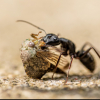- Formiculture.com
- Forums
- Gallery
- Members
- Member Map
- Chat

How many nuptial flights per year?
Started By
FelixTheAnter
, Jul 13 2021 2:24 AM
2 replies to this topic
#1
 Offline
-
Posted July 13 2021 - 2:24 AM
Offline
-
Posted July 13 2021 - 2:24 AM
It seems like I've seen many places say that all the queens of a species fly at the same time. But it seems I've also read that there will be multiple flights per year. How exactly does that work?
I want to catch an L. Niger queen, and just saw someone from here in the Netherlands say that the queens were flying yesterday. They were in the very south of NL, I'm in the north. I haven't seen a single queen, and I even had a blacklight on in my yard for a couple hours last night. Is it likely that they all fly at once...in different times in different regions? Just curious how this all works
I want to catch an L. Niger queen, and just saw someone from here in the Netherlands say that the queens were flying yesterday. They were in the very south of NL, I'm in the north. I haven't seen a single queen, and I even had a blacklight on in my yard for a couple hours last night. Is it likely that they all fly at once...in different times in different regions? Just curious how this all works
#2
 Offline
-
Posted July 13 2021 - 3:07 AM
Offline
-
Posted July 13 2021 - 3:07 AM
Yea usually that's how it works. And in tropical areas queens usually fly year round after rains.It seems like I've seen many places say that all the queens of a species fly at the same time. But it seems I've also read that there will be multiple flights per year. How exactly does that work?
I want to catch an L. Niger queen, and just saw someone from here in the Netherlands say that the queens were flying yesterday. They were in the very south of NL, I'm in the north. I haven't seen a single queen, and I even had a blacklight on in my yard for a couple hours last night. Is it likely that they all fly at once...in different times in different regions? Just curious how this all works
Sent from my CPH2201 using Tapatalk
Young ant keeper with a decent amount of knowledge on local ant species.
YouTube: https://m.youtube.co...uKsahGliSH7EqOQ (It's pretty dead. Might upload again soon, don't expect my voice to sound the same though.)
Currently kept ant species, favorites have a star in front of their names (NOT in alphabetical order, also may be outdated sometimes): ★ Camponotus irritans inferior, ★ Ooceraea biroi, Pheidole parva, ★ Nylanderia sp., ★ Paraparatrechina tapinomoides, Platythyrea sp., Anochetus sp., Colobopsis sp. (cylindrica group), ★ Crematogaster ferrarii, Polyrhachis (Myrma) cf. pruinosa, Polyrhachis (Cyrtomyrma) laevissima, Tapinoma sp. (formerly Zatapinoma)
Death count: Probably over a hundred individual queens and colonies by now. I cannot recall whatsoever.
YouTube: https://m.youtube.co...uKsahGliSH7EqOQ (It's pretty dead. Might upload again soon, don't expect my voice to sound the same though.)
Currently kept ant species, favorites have a star in front of their names (NOT in alphabetical order, also may be outdated sometimes): ★ Camponotus irritans inferior, ★ Ooceraea biroi, Pheidole parva, ★ Nylanderia sp., ★ Paraparatrechina tapinomoides, Platythyrea sp., Anochetus sp., Colobopsis sp. (cylindrica group), ★ Crematogaster ferrarii, Polyrhachis (Myrma) cf. pruinosa, Polyrhachis (Cyrtomyrma) laevissima, Tapinoma sp. (formerly Zatapinoma)
Death count: Probably over a hundred individual queens and colonies by now. I cannot recall whatsoever.
#3
 Offline
-
Posted July 13 2021 - 4:38 AM
Offline
-
Posted July 13 2021 - 4:38 AM
Good to know! I was also just looking for pupae of Camponotus, and when I pulled back some dead tree bark there was a huge L. Niger colony behind it. I saw the largest Lasius pupae I've ever seen, so I'm assuming they are alates. Does that mean there's probably several days still before the nuptial flights?
And how long after a local flight can you expect find queens?
And how long after a local flight can you expect find queens?
- Swirlysnowflake likes this
0 user(s) are reading this topic
0 members, 0 guests, 0 anonymous users













